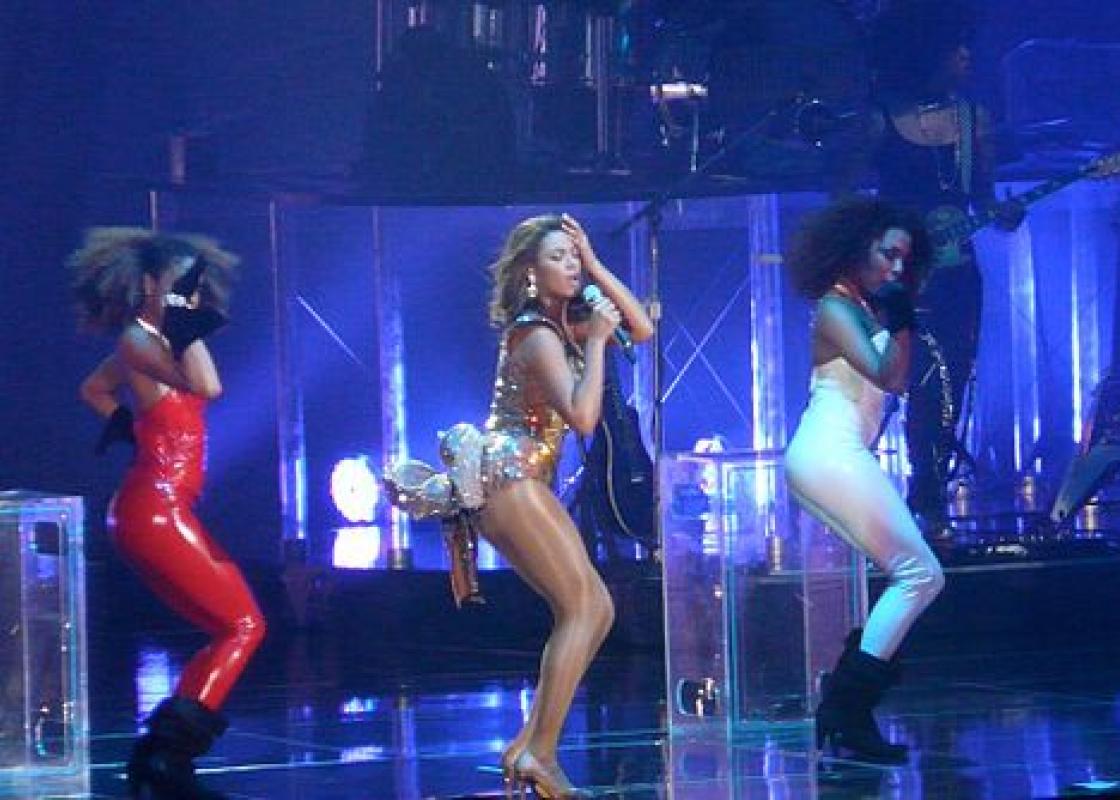“We often hear in the current discussion about why some boys struggle at school that it’s not natural for them to sit quietly and that they should have gym every day to help with this. But based on what I saw at the school, girls also have a great need to be active physically and they have far fewer outlets for this than the boys,” says Gro Anita Kamsvåg, who recently defended her doctoral thesis on music education in the ninth grade of a Norwegian lower secondary school at the Norwegian Academy of Music.
Kamsvåg observed all of the music classes for half a year. She also observed the pupils during break and followed them in all of their classes for one week. Initially she had not planned to focus primarily on gender in her thesis, but the topic emerged naturally when the class got an assignment to divide themselves into groups and work together on a long-term music project. They could compose a piece of music or rehearse a dance number or piece of music. The pupils divided themselves into all-girl or all-boy groups, and the groups took completely different approaches to the assignment.
“They chose different songs, different instruments and they behaved totally differently during rehearsals. Quite simply, there was completely different energy in the room, depending on if it was boys or girls rehearsing there,” says Kamsvåg.
Serious boys, giggly girls
“Both genders made traditional choices: The boys chose rock songs, and displayed concentration, earnestness, calm and control when they rehearsed. The girls chose pop, and they were concerned with how they looked, about being nice to each other, and they wanted to avoid physical pain, such as sore fingertips from playing the guitar. They also wanted to do well, but this was downplayed in relation to what happens in other school subjects.”
One of the boys’ groups broke up after a short time because two of the boys fought over the position as the lead guitar player. One of them left the group along with a friend, and these two rehearsed a medley of Metallica songs, with the more accomplished boy acting as instructor. The rest of the group continued as a traditional rock band.
“From a strictly visual standpoint, this type of music pervaded the school. For example, they had a wall mural of Metallica in one of the hallways. The music room had a very masculine feel – for instance, lots of guitars that seemed to appeal more to the boys than to the girls I observed,” says Kamsvåg.

“Where’s the stage?”
One of the girl’s groups was also organized as a traditional band, and rehearsed the 1960s song “Build Me Up, Buttercup” by The Foundations.
Watch The Foundations on YouTube.
“The girls in this group giggled and laughed a lot when they practiced – except for the group’s guitarist who sat bent over her guitar, disheartened over the technical challenges of the instrument,” says the researcher.
When the group’s mood was down, one of the girls would shout out “Where’s the stage?” That was the signal for them to rehearse their entrance onto the stage: One girl after another would jump up onto a fictive stage to the sound of a drum roll and cheering by the other girls. Everyone got their share of attention.
“The situation had clear elements of play, where it seemed that the most important thing was to let your imagination run wild,” says Kamsvåg.
This group was comprised of the most popular girls in the class, but when the day of the performance arrived, they did not take the stage by storm. The girls asked to be excused from performing in front of the class, and only the teacher got to see them perform.
Booty shake
Another girls’ group wanted to rehearse a dance, but they spent the first two months of the project period searching on YouTube for the right song to dance to. In the end they found the music video “Narulbwa” by the artist Lee Jung.
“After finding ‘Narulbwa’, the girls jump around on the floor, make some attempts to booty shake and giggle. They face the computer, which is placed in the back of the classroom roughly a metre from them. The picture of ‘Narulbwa’ doesn’t fill the entire screen, so they have to lean over in order to see while at the same time they stand with their legs apart, shaking and giggling. They can’t move too much before they bump into desks and chairs.”
The booty shake involves dance moves where the female dancers shake their bottoms vigorously. The girls tried to emulate the dancers in the video, but became giggly and uncertain from doing these movements. After a short time they gave up and wanted to look for a new song. Then the teacher put her foot down because she felt the girls were messing around, and she told them they had to sing instead. So they did. When the day arrived, the girls did perform for the class, albeit rather cautiously and quietly.
“The girls touched on the many discourses about the sexualized female body. Like very many videos, this one was quite sexually explicit, and the girls were aware of the public debate surrounding this type of video. They also seemed to be in possession of a kind of self-censorship and a conviction that there was something ‘dangerous’ about expressing themselves physically like an adult woman and not has a child or girl. Overall these factors became an obstacle to their expression,” says the researcher, and continues:
“You can believe what you want about the specific sexual and gender roles in music videos, but it’s a shame that the girls didn’t get to try out what they wanted to do most: dance and use their bodies. The girls also have bodies, and their hopping and jumping and playing and fooling around show they are drawn to the dramatic, the visual and the physical.”
Boys without musical skills
According to the researcher, the focus on bands did not appeal to the girls – or to the boys who had no skills in this genre. A final group of pupils consisted of those who were ‘left over’ after the pupils got to form their own groups. These included both boys and girls, but the two girls withdrew and were completely passive.
“The boys in this group had fewer musical skills than the other boys, and they shared little in common when it came to their tastes in music. As a result, it was difficult for them to find a direction, and the teacher was not helpful in this regard. These pupils probably gained the least from this type of teaching.”
Kamsvåg points out most of the pupils appreciated having the freedom of choice and that they got to do something practically oriented in these classes.
“Some of the groups produced things that were quite good musically. But when pupils are given so much freedom as they were here, a number of social mechanisms are activated which the teacher should keep a close eye on, both when it comes to gender and to processes of inclusion and exclusion.”
See also: "Feminine sound" ? poor dance music?
False and genuine
“The girls say they are going to sing, dance and imitate the music video. According to another pupil, Arne, there’s no way you can do that. It’s not possible to sing and dance simultaneously. Everyone who supposedly sings and dances at the same time use playback, he explains. If they don’t, they won’t have enough breath to sing. And using playback is cheating, he says and leaves. None of the girls respond to him.”
“The stamp of quality in music is often linked to traditional male practices. Authenticity is tied to the guitar, live performances, and the so-called ‘genuine’ and unembellished. Adornment, choreography and pop music, which are typically linked to girls, are viewed as less authentic. I ask myself, therefore, whether authenticity is a masculine construction that does not include the circuit of female discourse,” says Kamsvåg.

She says that although the class had an excellent music teacher, the school and the teacher indirectly gave their support to this notion of what constitutes quality in music. It was the guitar playing by the most skilled boys that received the most attention.
“The teacher loved to sing herself, and for precisely this reason she didn’t want to focus too much on that in the classroom because she wanted singing to be a hobby and not a job. Since the girls preferred to sing in addition to dance, they suffered the consequences. The same is true for the boys who were not good at playing an instrument or who had no genuine interest in learning to play.”
During the interview, the teacher also said she found it easier to get to know the boys in the class, who she said were ‘themselves’, while the girls were more conformist, she felt. The researcher saw this reflected in the teenagers’ views: While the boys were concerned about being individualistic in their musical tastes, the girls saw nothing wrong with conforming.
“Perhaps being like their girlfriends is a way to seek out security, and maybe this was manifested in particular in a musical setting because they didn’t feel this was an area where very much was expected of them. For the boys, there was more at stake, and it seemed like they felt they were expected to present their true selves through the music,” says Kamsvåg.
Dance during break!
According to the researcher, the girls who wanted to imitate the dancing in the music video did not get much recognition for this.
“This should be a topic of discussion for music education. The girls are directed away from their area of competency, which is to imitate songs and dancing in music videos. Do we want girls to be like boys and play Metallica, or is it better to give higher status to what the girls are interested in doing? These are also important questions in relation to movement, the body and sexuality.”
“The school debate should not be locked into a discussion of stereotypical boy and girl roles. The pupils perform in various contexts and show different sides of themselves. During the music classes, I saw the girls’ need for movement – it’s not only boys that don’t like to sit still all day long. Girls in lower secondary school also want to play and move about during break, but not in the same way as boys – they don’t want to play football. Maybe they want to skip or play hopscotch, but they are ‘too big’. But why not give them the opportunity to dance during break?”
Kamsvåg believes we need to think about what kind of femininity we keep alive when we talk about girls as quiet and attentive, in contrast to boys who are noisy and lack concentration. In this stereotype, the girls’ need for movement gets lost and the quiet boys disappear.
“Maybe the differences aren’t really so great? The body in motion is also the girl’s body. I think the schools need to do a better job at facilitating other opportunities for expression in gym and during break for those who don’t play football – both girls and boys,” concludes the researcher.
Translated by Connie Stultz.
See also: Cash's masculine vulnerability
Gro Anita Kamsvåg is a music educator and recently defended her doctoral thesis entitled Tredje time: musikk: en pedagogisk-antropologisk studie av musikkaktivitet og sosial organisasjon i ungdomsskolen (“Third Hour Class – Music: An Educational-Anthropological Study of Music Activity and Social Organization in Lower Secondary School”) at the Norwegian Academy of Music.


